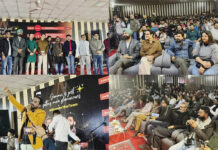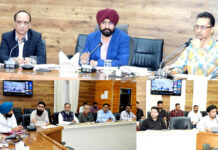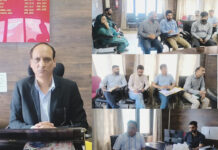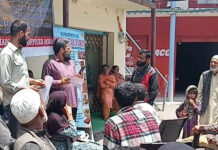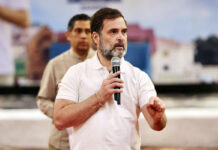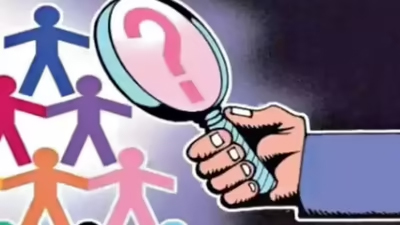DH NEWS SERVICE
JAMMU, JUNE 4
NEW DELHI, Jun 4: Census exercise with caste enumeration will be carried out with the reference date of October 1, 2026, in snow-bound areas like Ladakh and of March 1, 2027, in the rest of the country, the Home Ministry announced on Wednesday.
It has been decided to conduct Population Census-2027 in two phases along with the enumeration of castes, it said.
“The reference date for Population Census – 2027 will be 00:00 hours of the first day of March 2027.
“For the Union Territory of Ladakh and the non-synchronous snow-bound areas of the UT of Jammu and Kashmir and states of Himachal Pradesh and Uttarakhand, the reference date will be 00.00 hours of the first day of October 2026,” the ministry said in a statement.
The notification for the intent of conducting the Population Census with these reference dates will be published in the official gazette “tentatively on 16.06.2025, as per provision of section 3 of Census Act 1948”, it said.
Officials said the second and final phase of the census will begin in February 2027 and conclude on 01 March 2027 (reference date).
It is immediately not clear whether the exercise to update the National Population Register (NPR) will be carried out along with the Census or not. The government was planning to do it along with the Census in 2020 but the exercise was postponed due to the COVID-19 outbreak.
The Census of India is conducted under the provisions of the Census Act, 1948 and the Census Rules, 1990.
The last Census was conducted in 2011 in two phases: Phase I of House Listing (HLO) from April 1 to September 30, 2010) and Phase II of Population Enumeration (PE) (February 9 to 28, 2011) “with reference date – 00:00 hours of the first day of March 2011, except for snow-bound non-synchronous areas of Jammu and Kashmir, Uttarakhand and Himachal Pradesh for which it was conducted during September 11 to 30, 2010 with reference date as 00.00 hours of the first day of October 2010”.
Census 2021 was also proposed to be conducted in two phases with phase I during April-September 2020 and the second phase in February 2021.
The government recently decided that it will carry our caste enumeration along with the census. It will also be the first digital census giving the citizens an opportunity to self-enumerate.
The entire Census exercise is likely to cost the government over Rs 13,000 crore.
A meeting of the Union cabinet on December 24, 2019, approved the proposal for conducting the Census of India 2021 at a cost of Rs 8,754.23 crore and updating the NPR at a cost of Rs 3,941.35 crore.
However, the Budget 2025-26 allocated just Rs 574.80 crore for census surveys and statistics/the Registrar General of India (RGI).
A government functionary said the budget was a minor issue and could be sorted out without any impediment.
On April 30, the Cabinet Committee on Political Affairs chaired by Prime Minister Narendra Modi decided to include caste enumeration in the upcoming census.
The decision demonstrated that the Modi government is committed to the holistic interests and values of the nation and society, an official statement issued by the government on April 30 said.
According to Article 246 of the Constitution, the Census is a subject listed at 69 in the Union List in the Seventh Schedule.
While some states have conducted surveys to enumerate castes, these surveys have varied in transparency and intent, with some conducted purely from a “political angle, creating doubts in society”, the government had said.
“Considering all these circumstances, and to ensure that our social fabric does not come under political pressure, it has been decided that caste enumeration should be included in the main census instead of being conducted as a separate survey,” the statement said.
This will ensure that society becomes stronger economically and socially, and the country’s progress continues without hindrance. It is noteworthy that when a provision of 10 per cent reservation was made for the economically weaker sections of society, it did not create tension in any section of society, it said.
Caste was excluded from all census operations conducted since independence.
In 2010, then Prime Minister Manmohan Singh had assured the Lok Sabha that the matter of caste census would be considered in the Cabinet.
A Group of Ministers was formed to deliberate on this subject, and most political parties recommended conducting a caste census. However, the previous Congress-led government opted for a survey instead of a caste census, known as the Socio-Economic and Caste Census (SECC).
The Office of the Registrar General and Census Commissioner had prepared around three dozen questions to be asked to the citizens.
The questions include whether a family has a telephone, internet connection, mobile or smartphone, bicycle, scooter or motorcycle or moped and whether they own a car, jeep or a van.
The citizens were be asked questions such as the cereal they consume in the household, the main source of drinking water, the main source of lighting, access to latrine, type of latrine, wastewater outlet, availability of bathing facility, availability of kitchen and LPG/PNG connection, main fuel used for cooking and availability of radio, transistor and television.
They were to be asked about the predominant material of floor, wall and roof of the census house, the condition of the census house, the total number of persons normally residing in the household, whether the head of the household is a woman, whether the head of the household belongs to Scheduled Caste or Scheduled Tribe, the number of dwelling rooms exclusively in possession of the household and the number of married couples living in the household among others.


